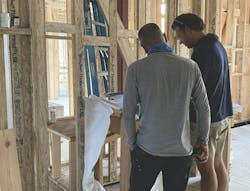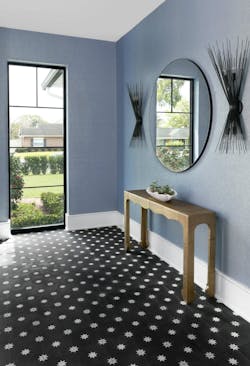It’s rare for an architect or designer to have truly unfettered creative freedom. During the process of designing and building a custom home, a host of constraints, compromises, and realities are inevitably in play, and the original intention or artistry of the design must evolve along with them. For some, sacrificing that original intent is an acceptable part of the design/build process, but to Zane Williams, founder and principal of custom building firm Z Properties, in Winter Park, Fla., it is not.
Williams is an acclaimed builder in his community. He’s a Greater Orlando Parade of Homes winner and was named an Exceptional Individual in 2018 by the City of Winter Park for his notable contributions to historic preservation in the area. He’s also a stickler for great design, so much so that he’ll prioritize design vision over budget in the process of building a home. “The home takes precedence over money,” Williams says. And he has built a business around that philosophy, designing and constructing homes that, while not always the most “mainstream,” are clear representations of his design intent and style, which he describes as “ever evolving.”
Of course, an essential component in any custom designed home is input from the client, who does—and certainly should—have influence in the process (it will be their home, after all). Williams wants to build the best home he can, as he sees it, which always means working with the client ... and sometimes working around them.
Ever-Evolving Design
“I want to stay ahead of trends,” Williams says, lamenting the “busyness” that is popular in much of today’s new-home design. “When I think of production or tract housing, I think of 900 can lights in a home with plastic trim, lots of rooflines that don’t align with window placement on the exterior, and so many different kinds of fake stone.” And then there are the electrical outlets: “Go into a condo and you’ll see an outlet every 8 feet,” he says, “with multiple outlets in hallways.” To reduce the aesthetic impact of outlets throughout the home, Williams’ homes often feature double or more ganged outlets. “In our work, we’re trying to strip away a lot of that excess.”
Williams gets to know his clients before designing their home. “When you see your client has good taste, you want to elevate that taste,” he says. But Williams is a forward-thinking designer, admitting it’s not always easy selling clients on things they haven’t seen before—even those who know his work or have worked with Z Properties previously. “If somebody comes to me because of something I’ve built, most times I’ve already moved on from what they’ve seen and I don’t want to build that again,” he says.
Williams is always on the lookout for new techniques and styles, seeking ideas from around the globe and weaving what he likes into his projects. Design influences include the Hamptons, Miami, Birmingham, Ala., and California, as well as South America, “where they’re using a lot of glazing and traditional materials,” he says. Other inspiration comes from the Alys Beach community in Florida’s panhandle—designed in the walkable, environmentally conscious style of New Urbanism by architects Marieanne Khoury-Vogt and Erik Vogt of Khoury Vogt Architects, in Rosemary Beach, Fla. “They’re some of the most talented people in the country,” Williams says.
In his own work, those influences manifest in a simple-yet-elegant modern, minimalist design language that favors natural materials—“real stone, real slate, real brick, Venetian plaster,” he says—and emphasizes natural light provided by large, high-end windows. “To me, windows absolutely make or break the architecture,” Williams says. “Our largest line item on a project will be its windows package.”
Working with a client whose tastes may not hew precisely to Williams’ own doesn’t doom a project, but it does require up-front conversations between builder and client. “I take the offensive on home design. We get creative and push the boundaries of their expectations,” Williams says, sharing an analogy he uses with clients: “You see the new BMW on the road and it has a big new grille. You don’t like it the first four, five, eight times you see it. But after three or four months, you realize how outdated the old grille looked, and you like [the newer design],” he explains. “I tell my clients it’s OK if they look at my plans and don’t fall in love with them right away.”
Talking Money—to Not Talk Money
Design, though, isn’t typically Williams’ most challenging conversation with clients; it’s money. And by the time plans are approved and construction is ready to get underway, Williams wants to be done talking money with his clients. “It makes for tougher conversations on the front end and complete transparency on budgeting,” he says. “But construction is already hard. I don’t want to make it harder by having to talk about money every time there is a change or problem.”
And there will be changes. “Either I’m going to want something changed, or the client will, or there will be a problem that requires it,” Williams says, adding that he often walks the jobsite during framing and makes changes on the fly in response to seeing his plans in physical form. “Framing is a critical point for me. I’m tweaking doorways or openings, or shifting walls, or will want to move a window,” he says, calling it part of his design process. “Sometimes I just need to feel it.”
Williams budgets for the unexpected by including a slush fund for design changes as a line item, which may be up to $20,000, depending on the project. “I want the ability to go and change things during framing and not ask for permission,” he says. An honest conversation with clients pre-construction allows him to lay out both what the slush fund is and how he’ll use it. “That money conversation is easier to have in your office, where the client can buy into it, than when you’re on the jobsite,” he explains. “Otherwise, every change you or the client want to make during construction turns into a conversation about money, and you end up always talking about money.”
While line items akin to Williams’ design slush fund aren’t unheard of in custom-home building budgets, what is unique is his unwillingness to compromise his vision. “The product takes precedence over everything—over money, over the client,” he says. That means that when the slush fund runs dry and there are changes that need to be made, Williams is paying out of pocket. “I’m always going to put the project over money. I believe, at the end of the day, I will be paid off for that.”

